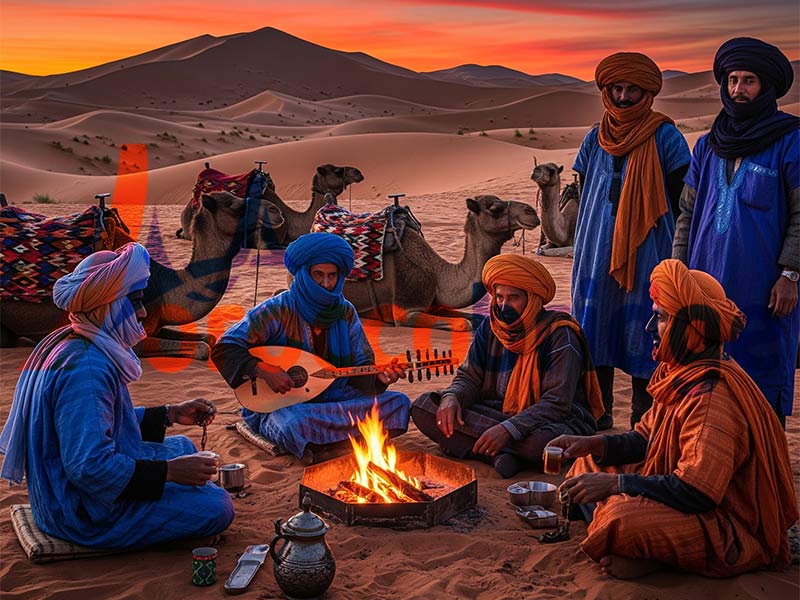Meet the Nomads: An Unfiltered Moroccan Desert Experience – Most travelers dream of riding camels over golden dunes and sleeping under Saharan stars. But beyond the popular tours and Instagram photos lies a more profound, raw, and unfiltered experience—life with Morocco’s nomads. These are the true custodians of the desert, living far from cities, roads, and even modern tourism, preserving a way of life that hasn’t changed in centuries.
In this article, you’ll learn what it’s really like to spend time with Morocco’s desert nomads: how they live, how you can respectfully visit them, and why this experience can completely reshape your idea of travel.
Who Are the Moroccan Nomads?
Moroccan nomads, particularly those in the Sahara Desert, are part of ethnic groups like the Aït Atta, Tuareg, and Arab Bedouins. They live in seasonal migration, moving with their livestock between oases and grazing lands.
They build temporary homes out of goat hair tents (khaima), rely on natural springs and wells, and carry centuries of wisdom about survival in the harshest environments.
Why Visit Nomads Instead of a Standard Desert Tour?
While most tourists book short overnight camps in Merzouga or Zagora, those are often commercialized setups. To experience the desert as the nomads do, you need to leave the paved roads and go deeper—towards Erg Chigaga, Jebel Bani, or the Draa Valley.
What makes it unfiltered:
- No running water or electricity.
- Cooking over fire with minimal tools.
- Learning to live with the rhythm of the desert: sunrise, prayer, silence, stars.
What You’ll Experience
1. Daily Life & Chores
You won’t be a tourist—you’ll be a guest. Expect to help gather wood, fetch water, or herd goats. This hands-on involvement creates real connection and appreciation.
2. Nomadic Cooking
You’ll eat fresh flatbreads baked in sand ovens, simple yet rich vegetable stews, and drink endless glasses of sweet tea under the stars.
3. Sleeping in a Khaima Tent
Forget luxury. You’ll sleep on rugs, under thick wool blankets, surrounded by silence—true silence.
4. Conversations Without Words
Many nomads speak only Tamazight or Hassaniya Arabic, but smiles, gestures, and shared meals speak volumes. Some children may speak basic French or even a little English.
5. Camel Caravans & Sandstorms
If you’re lucky (or unlucky), you’ll witness a real sandstorm or watch a caravan of nomads crossing the dunes on camels—an image straight from history.
Where to Find Nomadic Families
You can’t book this on TripAdvisor—and that’s the point. But you can still connect with local guides and ethical tourism networks who arrange real nomad stays:
| Region | Access Point | Nomadic Area | Tip |
|---|---|---|---|
| M’Hamid El Ghizlane | Zagora | Erg Chigaga & Bani Mountains | Best for remote nomadic experience |
| Tamegroute | Draa Valley | Nomadic tribes in palm oases | Cultural blend of nomads and villagers |
| Merzouga (carefully) | Erfoud | Near Erg Chebbi | Go far beyond the dunes, not tourist camps |
How to Visit Respectfully
- Go with a trusted local guide – They understand tribal customs and will help interpret.
- Don’t expect luxury – This is not a photo op; it’s a way of life.
- Ask before photographing – Especially women and elders.
- Bring useful gifts – Like tea, sugar, or school supplies for children.
- Dress modestly – Long sleeves, head coverings, and loose clothing are ideal.
Is It Safe?
Yes—nomadic communities are peaceful, and Moroccan hospitality is legendary. That said, the desert is remote. Always go with a certified guide, ensure you have enough water, and inform someone of your travel plans.
Why It’s Life-Changing
Spending time with Moroccan nomads strips away modern distractions and reconnects you with the essentials of life: water, food, shelter, community, and nature. Many travelers describe it as transformative, spiritual, and humbling.
You’ll leave with:
- A deeper respect for simplicity
- Insight into how little we actually need to be content
- Stories that no photo or blog post can ever fully capture
FAQs: Nomadic Life in the Moroccan Desert
Can I visit nomads independently?
It’s not recommended. Most nomads live far from towns and roads. A local guide is essential.
Are these trips suitable for children or families?
Yes—but only for families who are comfortable with basic conditions and open to adventure.
What should I bring?
Sun protection, a sleeping bag, snacks, a solar charger, and gifts like sugar, dates, or notebooks for children.
What’s the best time to go?
October to April. Summer is extremely hot and can be dangerous.
Final Thoughts
If you want more than just photos of the dunes—if you want truth, depth, and connection—spend time with Morocco’s nomads. It’s not comfortable, it’s not easy, but it will be one of the most authentic and powerful travel experiences you’ll ever have.
Important places to visit in Morocco:
- Rabat’s Best Beaches & Coastal Adventures
- Unforgettable Day Trip to Ouarzazate
- Hiking & Nature in Chefchaouen
- Essaouira: The Windy City’s Coastal Charm & Historic Medina


